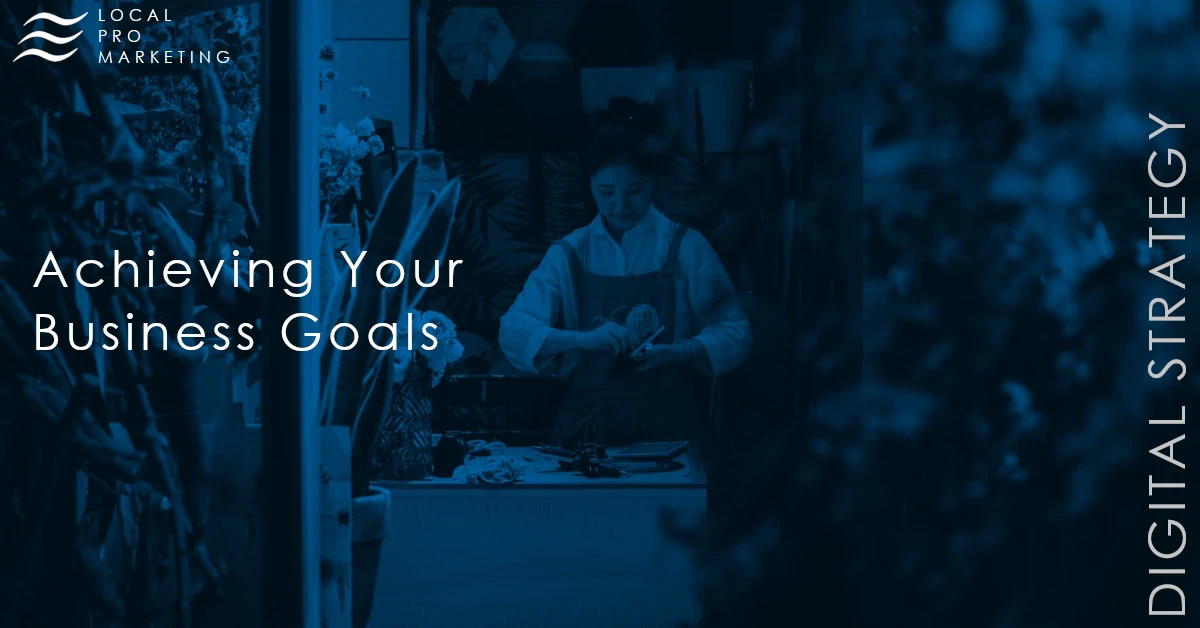Digital marketing has become an essential component of any successful business strategy. It’s no longer just an option, but a requirement. With the vast majority of people spending a significant amount of their time online, businesses must take advantage of digital channels to promote their brand and connect with their target audience.
Many small business owners may not fully understand the purpose and objectives of digital marketing. At its core, digital marketing is all about using digital channels to promote your brand, reach a wider audience, and achieve your business goals. The main objective of digital marketing is to help businesses increase their visibility, drive traffic to their website, and ultimately convert leads into paying customers.
To achieve these objectives, businesses need to develop a solid digital marketing strategy that incorporates a variety of tactics and tools. This may seem daunting at first, but with the right strategy and approach, digital marketing can be a powerful tool to help businesses grow and thrive.
We’ll explore the key objectives of digital marketing and the essential elements of a successful digital marketing strategy. We’ll discuss how businesses can use digital marketing to increase brand awareness, drive traffic to their website, generate leads and conversions, and build customer loyalty. We’ll also provide real-life examples of successful digital marketing campaigns to inspire and guide businesses as they develop their own strategies.

Increasing Brand Awareness
One of the key objectives of digital marketing is to increase brand awareness. In today’s crowded marketplace, it’s essential for businesses to make their brand stand out and reach a wider audience. By promoting their brand on digital channels like social media, search engines, and email, businesses can increase their visibility and build brand recognition.
Social media platforms like Facebook, Twitter, and Instagram are powerful tools for building brand awareness. By creating engaging content and sharing it with their followers, businesses can increase their reach and attract new followers. Social media also allows businesses to engage with their audience in real-time, responding to comments and questions and building a sense of community around their brand.
Search engine optimization (SEO) is another critical element in increasing brand awareness. By optimizing their website and content for search engines, businesses can improve their visibility in search results and attract more visitors to their website. This involves using relevant keywords, creating high-quality content, and ensuring their website is mobile-friendly and easy to navigate.
Email marketing is another effective way to increase brand awareness. By sending regular newsletters and promotional emails to their subscribers, businesses can keep their brand top-of-mind and encourage repeat visits to their website.
Increasing brand awareness is a crucial objective of digital marketing. By leveraging the power of social media, SEO, and email marketing, businesses can build their brand recognition and reach a wider audience. By focusing on creating valuable and engaging content, businesses can establish themselves as thought leaders in their industry and build trust with their audience, ultimately leading to increased conversions and revenue.

Driving Traffic to Your Website
Driving traffic to your website is a critical objective of digital marketing. After all, your website is the hub of your online presence and is often the first point of contact that potential customers have with your brand. By using a combination of tactics and tools, businesses can increase their website traffic and improve their chances of converting leads into customers.
Search engine optimization (SEO) is one of the most important tactics for driving traffic to your website. By optimizing your website and content for search engines, you can improve your website’s visibility in search results and attract more visitors to your site. This involves using relevant keywords, creating high-quality content, and ensuring your website is mobile-friendly and easy to navigate.
Paid advertising is another effective way to drive traffic to your website. Pay-per-click (PPC) advertising allows businesses to place targeted ads on search engines and social media platforms, driving traffic to their website and generating leads. By targeting specific keywords and demographics, businesses can reach their ideal audience and improve their chances of converting leads into customers.
Social media marketing is another powerful tool for driving traffic to your website. By sharing your website content on social media platforms and engaging with your audience, you can increase your reach and attract more visitors to your site. Social media also allows businesses to build strong relationships with their audience, ultimately leading to increased conversions and revenue.
Driving traffic to your website is all about providing value to your audience. By creating high-quality content that resonates with your audience and solves their problems, you can attract more visitors to your site and improve your chances of converting leads into customers. By using a combination of SEO, paid advertising, and social media marketing, businesses can drive more traffic to their website and achieve their business goals.

Generating Leads and Conversions
Generating leads and conversions is the primary objective of digital marketing for most businesses. After all, the ultimate goal is to turn website visitors into paying customers. By creating compelling content and offers, businesses can capture the attention of potential customers and encourage them to take action.
One of the most effective ways to generate leads is through content marketing. By creating high-quality content that provides value to your audience, you can attract visitors to your website and encourage them to engage with your brand. This can include blog posts, videos, infographics, and other types of content that address your audience’s pain points and interests.
Calls-to-action (CTAs) are another important tool for generating leads and conversions. By including CTAs on your website and in your content, you can encourage visitors to take the next step in the customer journey, whether that’s signing up for a newsletter, filling out a contact form, or making a purchase. CTAs should be clear, concise, and compelling, with a strong emphasis on the benefits that customers will receive.
Email marketing is another powerful tool for generating leads and conversions. By building an email list and nurturing your subscribers with valuable content and offers, you can keep your brand top-of-mind and encourage repeat business. Email marketing can also be used to promote new products or services, announce sales and promotions, and provide personalized recommendations based on customer behavior.
Conversion rate optimization (CRO) is a process of improving the user experience on your website to increase the likelihood of conversions. By analyzing website data and making changes to website design, content, and CTAs, businesses can improve their conversion rates and generate more leads and revenue.
Generating leads and conversions is all about understanding your audience and providing value at every stage of the customer journey. By using a combination of content marketing, CTAs, email marketing, and CRO, businesses can capture the attention of potential customers and encourage them to take action.

Building Customer Loyalty
Building customer loyalty is an important objective of digital marketing that often gets overlooked. While it’s essential to attract new customers and generate leads, it’s equally important to build strong relationships with your existing customers.
One of the best ways to build customer loyalty is through engagement on social media. By regularly posting high-quality content that resonates with your audience and responding to comments and messages, you can create a sense of community and strengthen your brand’s relationship with your followers. Social media can also be used to provide customer service and support, which can go a long way in building customer loyalty and satisfaction.
Another effective strategy for building customer loyalty is through email marketing. By sending personalized messages and offers to your existing customers, you can show them that you value their business and appreciate their loyalty. This can include exclusive discounts, early access to new products or services, and personalized recommendations based on their purchase history.
Providing excellent customer service is also essential for building customer loyalty. By responding quickly to customer inquiries and resolving issues in a timely and professional manner, you can create a positive experience that encourages customers to return in the future. This can include offering live chat support, phone support, or a self-service knowledge base.
Loyalty programs can be a powerful tool for building customer loyalty. By offering rewards and incentives for repeat business, you can encourage customers to come back again and again. This can include point-based systems, exclusive discounts, or even VIP access to special events or products.
Building customer loyalty takes time and effort, but it’s well worth it in the long run. By engaging with your customers on social media, providing excellent customer service, and offering rewards and incentives for repeat business, you can create a loyal customer base that will support your business for years to come.

Key Elements
To achieve your digital marketing objectives, you need to develop a comprehensive strategy that incorporates a variety of tactics and tools. Here are some of the key elements you need to consider when building your digital marketing strategy:
- Content Marketing: This involves creating valuable and relevant content that resonates with your target audience and drives traffic to your website. Your content can take many forms, such as blog posts, videos, infographics, and whitepapers, and should be tailored to the interests and needs of your audience.
- Search Engine Optimization (SEO): This involves optimizing your website and content for search engines so that your website ranks higher in search results. This includes keyword research, on-page optimization, and link building.
- Social Media Marketing: This involves using social media platforms like Facebook, Twitter, and LinkedIn to connect with your audience and promote your brand. You can use social media to share your content, engage with your followers, and run paid advertising campaigns.
- Pay-Per-Click (PPC) Advertising: This involves using paid advertising on search engines and social media platforms to drive traffic to your website and generate leads. PPC can be an effective way to reach your target audience and quickly drive results.
- Email Marketing: This involves using email to promote your brand, nurture leads, and build customer relationships. With email marketing, you can send personalized messages to your subscribers, promote your content and offers, and provide customer service and support.
- Analytics and Reporting: This involves measuring the success of your digital marketing efforts and using data to improve your strategy over time. By tracking key metrics like website traffic, leads, and conversions, you can identify areas for improvement and optimize your strategy for better results.
By incorporating these elements into your digital marketing strategy, you can achieve your business objectives and connect with your audience in a meaningful way. Keep in mind that your digital marketing strategy should be flexible and adaptable, as new technologies and trends emerge over time. By staying up-to-date and continually refining your approach, you can stay ahead of the competition and achieve long-term success.
To succeed in digital marketing, it’s important to develop a solid strategy that incorporates a range of tactics and tools. By focusing on content marketing, search engine optimization, social media marketing, pay-per-click advertising, email marketing, and analytics and reporting, you can create a comprehensive digital marketing plan that delivers results.
t’s important to remember that digital marketing is a constantly evolving field. New technologies and trends emerge all the time, and what works today may not work tomorrow. To stay ahead of the curve, it’s important to stay up-to-date on the latest developments in digital marketing and be willing to adapt your strategy as needed.
Digital marketing is a powerful tool that can help you achieve your business goals, connect with your audience, and build long-lasting relationships with your customers. By mastering the art of digital marketing, you can unlock new opportunities for growth and success in today’s digital marketplace.



